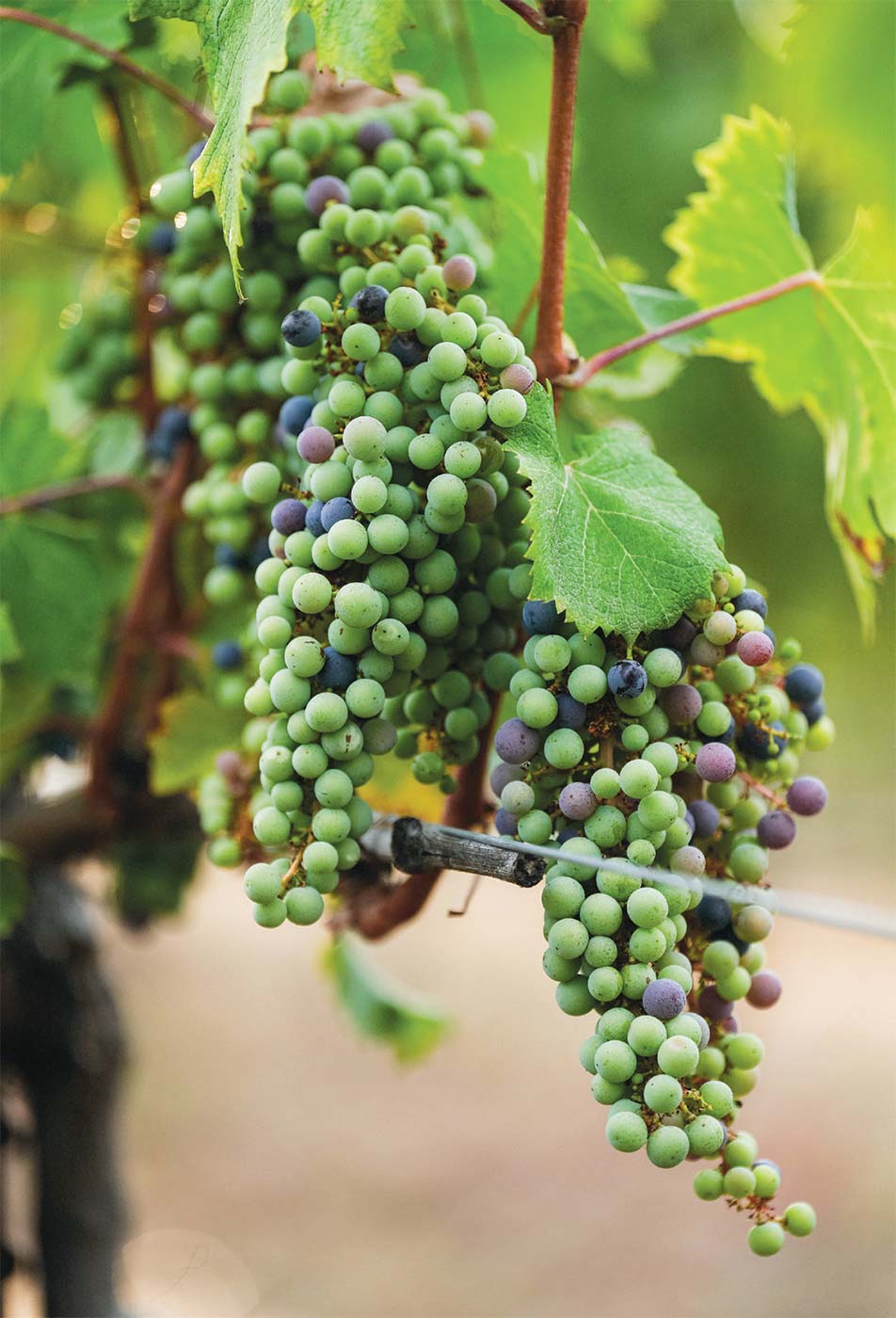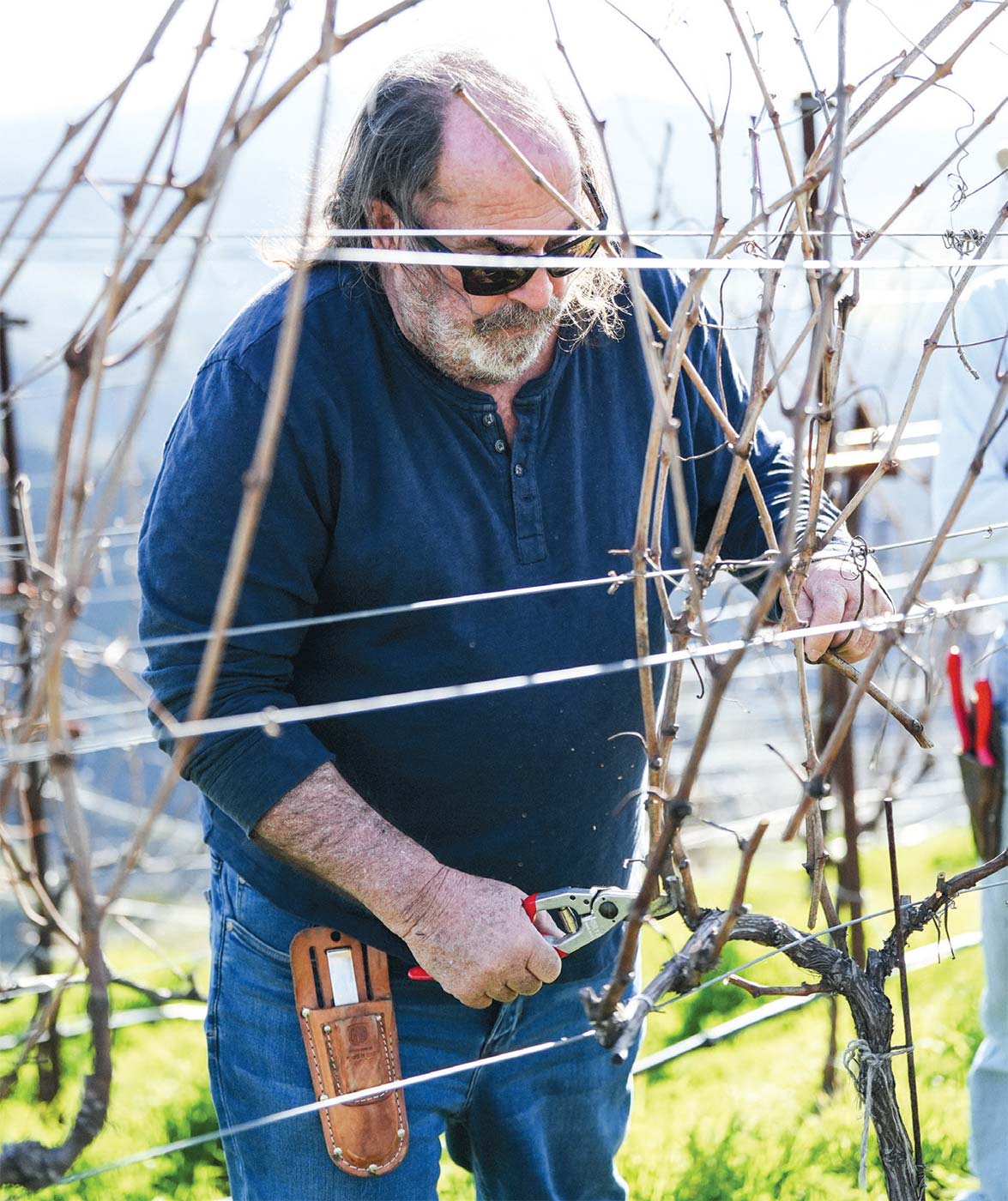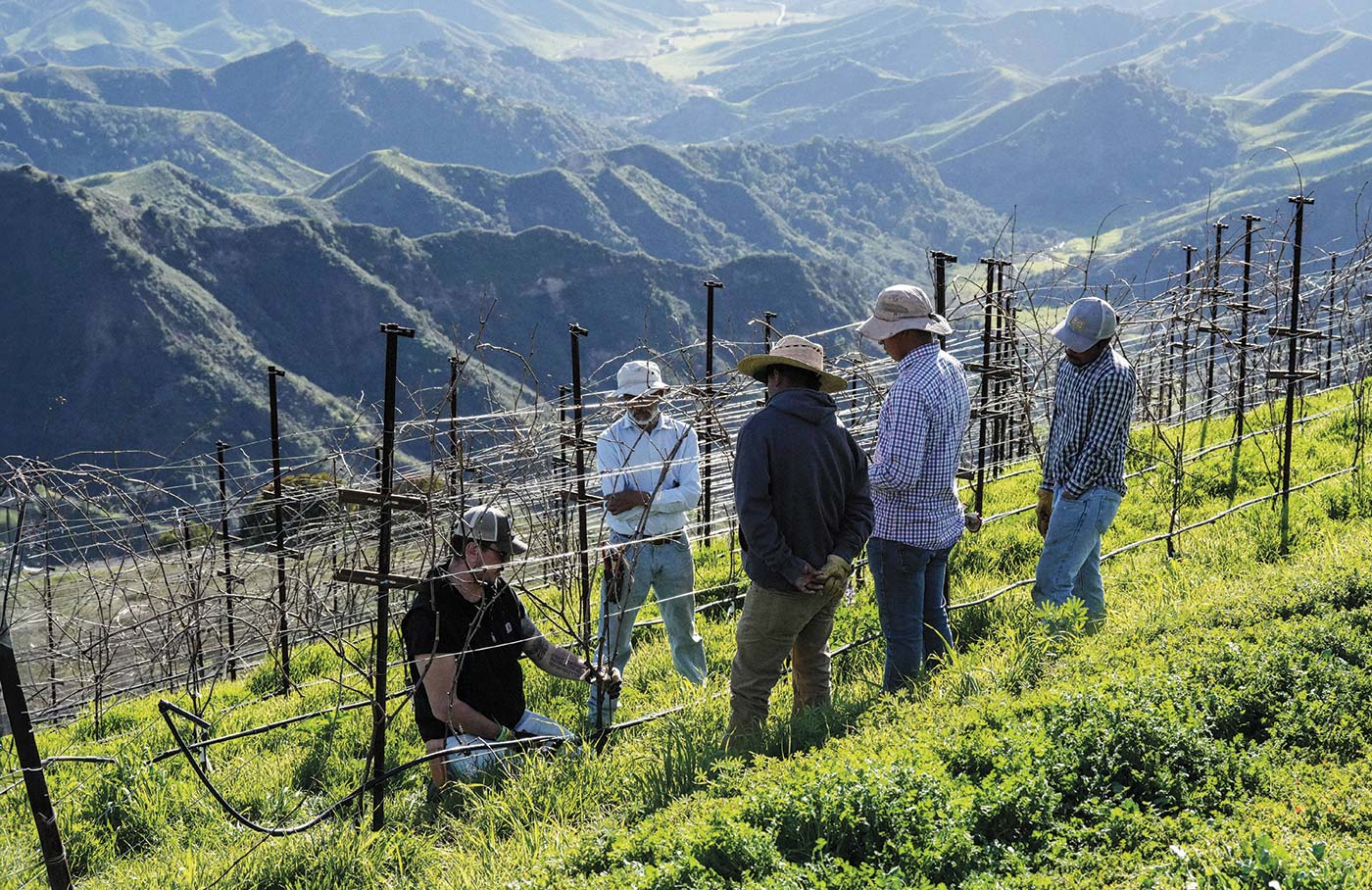Lofty Expectations
“NOBODY SAYS 2,800 FEET!” exalts Erich Bradley, renowned winemaker and founder of Sojourn Cellars in Sonoma, describing the extraordinarily high elevation of Ojai Mountain Winery and Vineyard. Twenty minutes from downtown Ojai, the 7.5-acre vineyard sits perched on the Sulphur Mountain hillside, part of a 120-acre estate Mike and Olga Chernov purchased in 2015.
They were not thinking of the specific altitude when they moved here, but rather of the Shangri-La-like feel and jaw-dropping views that span from Lake Casitas and the Topatopa Mountains to the Pacific Ocean and Santa Clara River Valley. Olga half-jokingly points out how you can see the infamous “Ojai Vortex” in the valley curves that sweep around their now nearly 300-acre property, as their home rests atop the intersection of complex fault systems that some credit for the positive, calming energy felt in the valley.
“The spectacular scenery really moved me,” she laughs. “I thought maybe we’d grow some food, plant a few trees. Then a friend at UC Davis Viticulture mentioned we are sitting on a gemstone for a vineyard,” so she started planting vines in 2018. A year later, at a wine club event in Sonoma, Olga casually mentioned her boutique vineyard’s elevation to Erich: “That got his attention! He was, like, ‘What did you say?!’ He flew in the next weekend.”
“I love the intensity and I love the concentration of high-elevation wines— and it’s here.” —Erich Bradley, winemaker and founder, Sojourn Cellars

UNIQUE CONDITIONS
Beyond the spectacular views, what motivates the frenzied appeal of this remote, rocky, windy, sun-battered, drought-ridden, fire-prone hillside for a world-class winemaker? “I love the intensity and I love the concentration of high-elevation wines—and it’s here,” says Erich.
Due to its elevation, this site has one of the most significant diurnal shifts in the country. “Sometimes we have 100° during the day and 50° at night,” explains Olga, “so the grapes ripen during the day, then at night everything is put on hold with the cool air. This extends Ojai Mountain’s growing season, and the grapes build acidity and flavor without building sugar.” In addition to its lofty elevation, Erich explains how the harsh conditions of Ojai Mountain are one of the most important factors that make the wine superb: “Your skin-to-juice ratios up here are very different. And the wines have the capacity to be more profound when they’re grown from a site like this.”
It’s steep and rocky; all the soil has been eroded to the valley floor and their site has been left covered in shale—but it drains well, which is crucial to prevent over-watering and promote overall root health. It’s exposed to harsh UV sun rays—but the plants receive a more even exposure to sunlight on sloped terrain than they would on flat ground, and the intense sun contributes to a thicker skin and bolder flavor. It’s prone to 60 mph winds that blow in off the ocean—but, like the intense sun exposure, this further thickens the grapes’ skin as they struggle to survive in these harsh elements, and further develops the “profound” flavor.
“Our wines have a deep red color because of the thick skin,” says Olga. The more abundant tannins that give their wine this darker color also contribute to the complexity and, because tannins are natural preservatives, the aging potential of the wine. Erich sums up his excitement over Ojai Mountain: “I am hooked.”
GOING FOR INTENSITY
It was not difficult to recruit Erich’s good friend, viticulturist Phil Coturri, and as Olga describes him, “celebrated father of biodynamic farming,” to work on Ojai Mountain. “Phil and I have this in common: an obsession with high-elevation sites,” says Erich. In particular, Phil became galvanized by the harsh nature of the elevation: “You want to grow a healthy, robust vine under the most challenging conditions. That’s where you get the intense flavors; that’s how you get terroir. Terroir is the soils, slopes, climate, aspects—and the attitude of the grower!”
Both winemakers concur that Rhone varietals seem to be the ideal wines for Ojai Mountain to produce, given the site’s climate similarities to the Rhone region in the south of France. Rhones are known for their drought-resistance; Syrah and Mourvèdre varieties in particular benefit from the Ojai elevation’s cooler night temperatures and sun exposure.
Phil’s key contribution to the Ojai Mountain project is his expertise in biodynamic farming. “When everyone was spraying the $%#@ out of everything, he was growing food organically, building the soil, doing things holistically, sourcing things locally. People were laughing at him. But then they started to notice the better results, and now he’s farming all the most famous vineyards in Napa and Sonoma,” says Olga. “It’s the only way I want to farm. My kids eat grapes right from the vines, so why would I want anything toxic?”
Biodynamic farming is especially important for vineyards because they are monocultures; lacking plant diversity they attract an excess of pests, which many growers turn to chemical spraying to prevent and remove. Phil has helped to educate Ojai Mountain’s on-site viticulturist, Martín Ramírez, on how to improve the soil and overall biodiversity of the vineyard through organic cover crops, like lupin and poppies, and manure from nearby horse and chicken farms.

Phil Coturri, legendary biodynamic viticulture consultant from Sonoma, enjoys the challenge of the terroir on Sulphur Mountain.
PRUNING WITH PURPOSE
Martín is not only managing the vineyard’s biodynamic practices, but also implementing cutting-edge pruning techniques (no pun intended!) developed by the successful Italian consultancy, Simonit&Sirch. The methodology involves making smaller cuts on one side of a branch offshoot, rather than cutting against the main branch, thereby minimizing damage to the vine. As a result, the vines are purportedly better able to combat fungal diseases that otherwise penetrate pruning wounds, and better able to withstand drought, an ability that otherwise becomes impaired by a damaged vascular system that affects sap flow and water uptake.
Martín is also experimenting with a European “head pruning” method, developed in regions where irrigation is not practiced, to help the plants grow a deep root system in the hot, dry climate. This entails training the vine to form a standalone bush-like structure with a short trunk that effectively creates shade to minimize overheating and sunburn. Martín reports that he is already “seeing the difference after one season of implementing [these pruning techniques],” including “better phenolic ripeness and balanced flavors, better fungus management, darker fruit colors and softer, more tender fruit characteristics.”
He’s incredibly optimistic about Ojai Mountain’s future in general, confidently saying, “It will become successful growing the best grapes and producing the best wines in the region… It is the cleanest, healthiest, most productive land in the area; besides that, it has the most beautiful views in the valley!”

Good wine grown biodynamically really does take a village to perfect. Among the “villagers” at Ojai Mountain Winery are (from left) Jacopo Miolo, master pruner Simonit&Sirch; Erich Bradley, winemaker; Martín Ramírez, head viticulturist onsite; David Brodowsky, hospitality manager; and Paul Hoffmeister, vineyard and property manager.
CLIMATE EXTREMES
Despite well-deserved exuberance around the winemaking potential (and views!) of Ojai Mountain, Olga remains realistic about the site’s challenges, especially in light of climate change and how it affects the winemaking industry worldwide: “Things are becoming more extreme. So when it’s hot, it’s hotter. When it rains, it floods. This is not good for wine.”
Last year they had rain and fog through June, which resulted in a significantly smaller yield than expected; neighbors who have lived on Sulphur Mountain since the 1970s had never experienced rain this late in the season. Still, Olga remains optimistic that Ojai Mountain is well-positioned to withstand the inevitable changes relative to some of the classic locations farmed for grapes: “Some famous vineyards may no longer be around because it becomes very difficult; it’s hard to produce wine of the same quality because it’s too hot and the wine becomes too sugary. Your two options are to go north, or go up [in elevation]. Luckily, we are up high in the mountains, so we are hoping to have a little bit less of [negative climate impacts].”
Not only does Ojai Mountain’s elevation help prevent overheating, and the site’s rocky soil helps prevent over-watering, but the property also has a natural aquifer that helps alleviate water scarcity. Between these natural geologic benefits and their biodynamic practices, pruning techniques and choice of wine varietals, Olga and her team are well positioned as they persevere amidst an uncertain climate.
The Ojai Mountain team understands that to make their project successful, they need to make a truly first-class wine. Olga explains matter-of-factly, “When we harvest, we can’t put in a tractor on the hillside, so the guys are running around with buckets. We have to transport everything up and down a long, winding road that’s far away from everything. It’s very old-fashioned, relying on human labor instead of heavy machinery, and hard and expensive work. So, the only way this works economically is to make a truly outstanding wine.”
Fortunately, the fruits of their labor are literally blooming, and Ojai Mountain’s wine has demonstrated success, even at this early stage of development. They plan to double the current size of the vineyard this spring.
The current lot is available on their website, and they hope to expand the purchasing options to local stores, and perhaps host wine dinners soon. Erich sums up Ojai Mountain’s potential succinctly: “It’s safe to say I’ve never been more excited about the intensity and the concentration this site produces.”
- To learn more and purchase wine visit OjaiMountainEstate.com.

Barn owls and red-tailed hawks are among the birds of prey released onto the vineyards at Ojai Mountain Winery in partnership with the Ojai Raptor Center.
A SYMBIOTIC RELATIONSHIP
Ojai Raptors Help Winery Take Flight
Olga Chernov has a special talent for identifying creative business opportunities. She wanted to eliminate traditional toxic pest control methods in her vineyard, and the Ojai Raptor Center wanted to release their rehabilitated birds, so voilà!, a symbiotic relationship ensued. Ojai Raptor Center Executive Director Kimberly Stroud explains how the partnership developed and benefits her organization.
How did this partnership with Ojai Mountain Winery come about?
I first met Olga when she purchased owl boxes for her property and winery about four years ago.
What are the benefits to this site?
It is a lot of property, so I can spread out releases, as we cannot overpopulate one site. Her property has not been using rodenticides or poison, and therefore it falls under our criteria for releasing birds of prey there.
What species have you released at Ojai Mountain?
I have released barn owls and kestrels, primarily, as they are the ones that hunt the target species she wants to control around the winery. This year I also released a couple of great horned owls.
What are your future goals for this partnership with Ojai Mountain?
I’d like to continue collaborating, and specifically by establishing and monitoring raptors in that area for success.
What are your recommendations to gardeners, farmers and arborists to prevent bird injuries?
Stop using rodenticides and herbicides, as this causes harm to natural predators, and use alternative measures, such as owl boxes, raptor perches and exclusion techniques. Additionally, tree trimming should be done in the late fall before birds begin to nest.
How can someone support your work?
We need funding for many projects centered on maintaining quality care for rehabilitating and releasing our raptor patients. Volunteering for the organization is always a need as well. Check out our website for more information about how to help wildlife in our community: OjaiRaptorCenter.org





